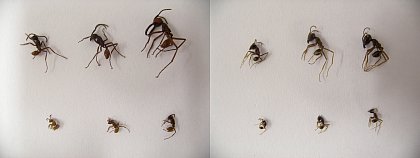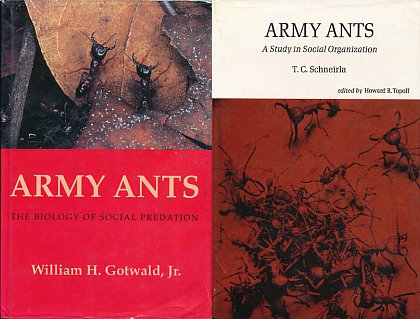Genetic population and colony structure in different army ant species.

The army ants are a heterogeneous group of ants (main subfamilies: Aenictinae, Dorylinae and Ecitoninae) of the Old and New World tropics that are characterized by the "army ant adaptive syndrome", a unique combination of traits: Obligate group predation, nomadism, and a permanently wingless queen. Further accompanying characteristics include an intricate worker polymorphism, huge colonies (up to millions of workers) that reproduce by fission, and a unique mating biology with sexual selection and multiple mating by queens (polyandry). Through massive group raids and efficient cooperation army ants are major predators, collectively overwhelming diverse kinds of arthropods. The reproductive cycle often consists of alternating nomadic phases with frequent emigrations, and statary phases with pupation of the larvae and egg-laying within the temporal nest (bivouac), which than may remain over weeks. Army ant males disperse on the wing. Finding a conspecific colony, they first have to be accepted by its workers, which "chose" the next fathers and kill rejected males. Accepted males copulate with the queen within the bivouac and die afterwards.
Ongoing Research

Army ants represent a highly interesting model to study the consequences of polyandry for social systems. We therefore investigate in the evolution and adaptive value of their mating systems and dispersal strategies by using molecular tools and population genetic approaches. We are in particular interested in the genetic colony composition and the effect of different paternal lineages in determining worker morphologies and establishing efficient division of labor. Moreover, analyzing the relatedness within army ant colonies, we test for the significance of sexual selection and male dependent dispersal for inbreeding avoidance and the maintenance of genetic diversity. We thereby use the well known model species Eciton burchellii as test system, but also comparative studies in presently poorly studied species that may give further insights into the evolution and ecological relevance of army ants. Our current research mainly focuses at the two Ecitoninae species E. mexicanum and Labidus praedator. Little is known about the mating biology and colony structure of those species. Additionally, we are interested in the population structure and dispersal abilities of southern African Dorylus army ants.

Selected Literature

- Brady, S.G. (2003): Evolution of the army ant syndrome: The origin and long-term evolutionary stasis of a complex of behavioral and reproductive adaptations. PNAS 100 (11): 6575-6579.
- Denny, A.J., Franks, N.R., Powell, S., Edwards, K.J. (2004): Exceptionally high levels of multiple mating in an army ant. Naturwissenschaften 91: 396-399.
- Franks, N.R., Hölldobler B. (1987): Sexual competition during colony reproduction in army ants. Biol J Linn Soc 30: 229-243.
- Franks, N.R., Sendova-Franks, A., Anderson, C. (2001): Division of labour within teams of New World and Old World army ants. Animal Behaviour 62: 635-642.
- Jaffé, R., Kronauer, D.J.C., Kraus, F.B., Boomsma, J.J., Moritz, R.F.A. (2007): Worker caste determination in the army ant Eciton burchellii. Biol Letters 3: 513-516.
- Jaffé, R., Moritz, R.F.A., Kraus, F.B. (2009): Gene flow is maintained by polyandry and male dispersal in the army ant Eciton burchellii. Popul Ecol 51: 227-236.
- Kraus, F.B., Moritz, R.F.A. (2010): Extreme polyandry in social Hymenoptera: evolutionary causes and consequences for colony organisation. In: Kappeler, P. (Ed.): Animal Behaviour: Evolution and Mechanisms. Springer, Berlin Heidelberg. pp. 413-439.
- Kronauer, D.J.C. (2009): Recent advances in army ant biology (Hymenoptera: Formicidae). Myrmecol News 12: 51-65.
- Kronauer, D.J.C., Johnson, R.A., Boomsma, J.J. (2007): The evolution of multiple mating in army ants. Evolution 61, 413-422.
- Rettenmeyer, C.W. (1963): Behavioral studies of army ants. U Kans Sci Bul 44: 281-465.
- Strassmann, J. (2001): The rarity of multiple mating by females in the social Hymenoptera. Insect Soc 48: 1-13.



